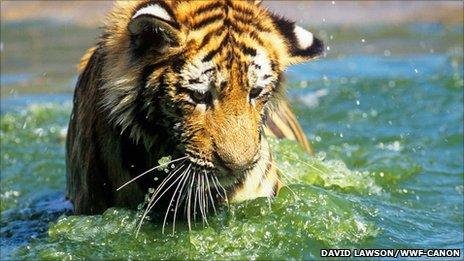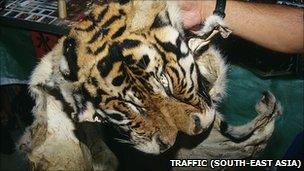Illegal tiger trade 'killing 100 big cats each year'
- Published

Fewer than 3,500 tigers are estimated to remain in the wild yet the illegal trade continues, the study warns
The illegal trade in tiger parts has led to more than 1,000 wild tigers being killed over the past decade, a report suggests.
Traffic International, a wildlife trade monitoring network, found that skins, bones and claws were among the most common items seized by officials.
The trade continues unabated despite efforts to protect the cats, it warns.
Over the past century, tiger numbers have fallen from about 100,000 individuals to just an estimated 3,500.
The study, which used data from 11 of the 13 countries that are home to populations of Panthera tigris, estimated that between 1,069 and 1,220 tigers were killed to supply the illicit demand for tiger parts.
'Poaching pressures'
Since October 1987, tigers have been listed as an Appendix I species (threatened with extinction) under the Convention on International Trade in Endangered Species of Wild Fauna and Flora (Cites), which means all commercial trade in the animals or their parts is banned.
thailand.jpg)
Some of the seizures revealed the shocking scale of the illegal trade
The figure was based on analysis of 481 seizures. More than 275 of the seizures were in India, which - the report's authors said - represented between 469 and 533 tigers.
China, with 40, had the second highest number of seizures, accounting for up to 124 animals, while Nepal reported 39 seizures, or 113-130 tigers, they added.
"Given half the world's Tigers live in India, it's no real surprise the country has the highest number of seizures," explained co-author Pauline Verheij, joint TRAFFIC and WWF tiger trade programme manager.
"While a high number of seizures could indicate high levels of trade or effective enforcement work, or a combination of both, it does highlight the nation's tigers are facing severe poaching pressure," she added.
"With parts of potentially more than 100 wild tigers actually seized each year, one can only speculate what the true numbers of animals are being plundered."
Drugs, weapons, wildlife
The authors said the data showed that the trade continued "unabated despite considerable and repeated efforts to curtail it on the part of tiger range and consumer countries, intergovernmental organisations and NGOs".

Skins were among the most common tiger parts seized by officials
Commenting on the findings, leader of WWF's Tigers Alive initiative Mike Baltzer said: "Clearly enforcement efforts to date are either ineffective or an insufficient deterrent.
"Not only must the risk of getting caught increase significantly, but seizures and arrests must also be followed up by swift prosecution and adequate sentencing, reflecting the seriousness of crimes against tigers," he added.
In March 2010, during the most recent high level meeting of Cites, nations agreed to increase intelligence sharing against criminal networks that smuggled big cat parts.
Speaking in 2009, World Bank chief Robert Zoellick said the global black market in wildlife products was worth about $10bn (£6bn) per year, making wildlife the third most valuable illicit commodity after drugs and weapons.
Conservationists also point to China's "tiger farms" as a threat to the wild animals because, they say, it perpetuates a market into which wild tiger parts can be sold, often commanding a higher value as products made from wild animals are perceived to be more "potent".
Although China does not officially permit the sale of goods from these farms, in practice several investigations have revealed tiger parts are being sold.
The report called for an improved understanding of the tiger trade and much tighter law enforcement.
"But good enforcement alone will not solve the problem," warned Steven Broad, executive director of Traffic.
"To save tigers in the wild, concerted action is needed to reduce the demand for tiger parts altogether in key countries in Asia."
Enforcement efforts to date, the authors concluded, "point to a lack of political will among those responsible at national and international levels".
They hoped the report would provide an "important baseline to inform the understanding of this persistent yet illegal trade".
- Published14 September 2010
- Published23 July 2010
- Published30 August 2010
- Published12 July 2010
- Published26 August 2010